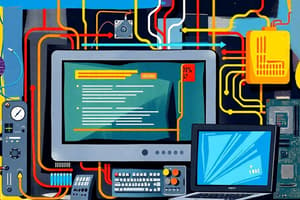Podcast
Questions and Answers
What are some activities that the operating system is responsible for in connection with disk management?
What are some activities that the operating system is responsible for in connection with disk management?
Free space management, storage allocation, disk scheduling
What is Utility Software?
What is Utility Software?
Specialized software that supports the OS in housekeeping tasks to increase efficiency of the computer system
Which interfaces are part of the user interface supported by the operating system?
Which interfaces are part of the user interface supported by the operating system?
- Command driven interface
- Menu driven interface
- Graphical user interface
- All of the above (correct)
What is another term for software that consists of a series of instructions telling the computer what to do?
What is another term for software that consists of a series of instructions telling the computer what to do?
Which of the following features are included in word processing software?
Which of the following features are included in word processing software?
Operating Systems coordinate activities among computer hardware.
Operating Systems coordinate activities among computer hardware.
_____ is a predefined formula that performs common calculations in spreadsheet software.
_____ is a predefined formula that performs common calculations in spreadsheet software.
Match the type of data processing with its description:
Match the type of data processing with its description:
What is the program that acts as an interface between the user and the operating system?
What is the program that acts as an interface between the user and the operating system?
Which of the following are functions of the operating system?
Which of the following are functions of the operating system?
Flashcards are hidden until you start studying
Study Notes
Introduction to Software
- Software consists of a series of instructions that tells the computer what to do
- Also known as a program, software can be categorized into two major categories: System Software and Application Software
Application Software
- Designed to make users more productive and/or assist with personal tasks
- Examples include:
- Word processing software (e.g., creating and manipulating documents)
- Spreadsheet software (e.g., organizing data, performing calculations, and creating charts)
- Presentation software (e.g., creating visual aids for presentations)
System Software
- Serves as the interface between the user, application software, and the computer's hardware
- Two types of system software are:
- Operating System (OS)
- Utility programs
Operating System (OS)
- A set of programs that coordinates all activities among computer hardware devices and allows users to run application software
- Examples of OS include:
- MS DOS
- Windows (3.X, 95, 98, ME, 2000, XP, NT, VISTA, 7, 8, 10, 11)
- Apple operating systems (MAC OS X, iOS)
- Linux and Unix
Booting Process
- The process of starting or restarting a computer
- Two types of booting processes are:
- Cold Boot (turning on a computer that has been powered off)
- Warm Boot (restarting a computer using the operating system)
Classification of OS
- Multi-user: allows two or more users to run programs at the same time
- Multiprocessing: supports running a program on more than one CPU
- Multitasking: allows more than one program to run concurrently
- Multiprogramming: allows different parts of a single program to run concurrently
- Real-time: responds to input instantly
Modes of Processing
- Batch Processing: data is collected and processed at a certain time (e.g., weekly, monthly)
- Online Processing: data is collected and processed immediately, user interacts directly with the computer
- Real-time Processing: inputting, processing, and outputting data continuously (e.g., anti-missile systems, aeroplane landing control system)
- Interactive Processing: simplest way to work on a system, using command line or graphical environment
- Time-sharing Processing: allows many users to use a computer system simultaneously
Components of OS
- Kernel: the main part of the OS, executes processes and handles interruptions
- Scheduler: initiates and terminates jobs, allocates computer resources
- Process Manager: enables processes, allocates resources, and protects resources
- File Manager: manages files and memory
- Shell: interface between the user and the OS, allows user to enter commands
Functions of OS
- Starting a computer
- Providing a user interface
- Managing computer resources
- Managing files and memory
- Maintaining security
- Managing tasks
- Multiprocessing
Process Management
- Allocates time for processes to use the CPU
- Keeps a check on other processes waiting to use the CPU
- Signals when CPU is available
Main Memory Management
- Allocates memory for programs and data
- Uses virtual memory to split large programs into manageable blocks
File Management
- Manages files in secondary storage
- Checks the amount of memory needed for file operations
- Organizes files in secondary storage
I/O System Management
- Manages the flow of information among devices
- Uses buffers to manage devices
Secondary Management
- Manages secondary storage (e.g., disk management)
- Allocates storage space
- Manages disk scheduling
Utility Software
- Supports the OS in housekeeping tasks
- Examples include:
- Protecting software against damage caused by viruses
- Making copies of files (back up) software
Studying That Suits You
Use AI to generate personalized quizzes and flashcards to suit your learning preferences.




